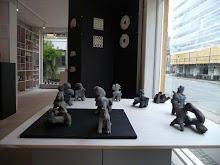
NATURE CULTURE OBJECT
Turi Heisselberg Pedersen & Marianne Krumbach DK
Exhibition 12 September – 19 October 2019
Nature Culture Object - the concepts branch into the exhibition pieces.
Turi Heisselberg Pedersen and Marianne Krumbach both work with ceramic sculptural pieces that have evolved away from the traditional form of the jar.





They describe their interest in the meeting between nature, culture and object.





Where Turi Heisselberg Pedersen aims for the viewer's intuitive understanding of the pieces, Marianne Krumbach talks about the importance of conveying her own subjective experience.
 TURI HEISSELBERG PEDERSEN's earlier organic vases have become geometric crystalline objects with almost invisible references to the vase's archetype.
TURI HEISSELBERG PEDERSEN's earlier organic vases have become geometric crystalline objects with almost invisible references to the vase's archetype. She reconciles nature's asymmetrical and irregular encounter with its own structural sense of order, beautifully related to the organic and structural formability of clay, and has a sublime sense of giving the surface a specific texturality that emphasizes the form.
 MARIANNE KRUMBACH describes herself as an interpreter, where it is not nature and objects that matter most, but the notion of them, and the meaning we as humans attribute to the things we surround ourselves with.
MARIANNE KRUMBACH describes herself as an interpreter, where it is not nature and objects that matter most, but the notion of them, and the meaning we as humans attribute to the things we surround ourselves with.She is interested in telling her own experiences based on something generally valid, which she discovers in nature/growth, - "a story of something crooked, fallen or uncertain, something that somehow strikes beside the perfect". In the new pieces, she looks for the abstract and the specific mood that she particularly wants to express.
NATURE CULTURE OBJECT opens up artistic interpretations of the concepts.
There are more questions than answers, but with the title the gallery wants to add a visual experience of the subject based on the pieces by the exhibitors.
- How does art use nature? Can nature be explained in the name of culture/art? How are the concepts linked so that they are further thought and reflected?
Is it the task of art to point to the importance of nature in our culture/society - or does the work of art point solely to itself, in its own right?
- Are the objects of art important in our culture, or do the nature's "objects" give preference to those of the culture?
The exhibitors embrace the theme personally and link the pieces to their own journey - and professional narration.
Turi Heisselberg Pedersen





My current pieces have moved away from the jar form, towards a more sculptural expression. Clusters of angular profiles or strange mixtures between geology and plant forms, architecture and origami. Botanical-ceramic objects, in which the forms resemble the irregular asymmetric structures and orders found in nature, such as rigid crystal forms or wild-growing organic structures.
I strive for the pieces to convey the irregularity, the beauty of rhythm, form, colour and composition.





The space between the figures, the colours and the interaction between the pieces are important, and I often work in series that work together in themes.
I aim for an intuitive understanding of the pieces: Nature, landscape, culture, memory, body.


 I am interested in a balance between the processed surface and the more imperfect, leaving traces of the process. The angular shapes fight against the nature of the clay, giving you an impression of the hand-built and imperfect. In this way, the angular shapes get a softer look, leading the mind towards natural shapes rather than constructions.
I am interested in a balance between the processed surface and the more imperfect, leaving traces of the process. The angular shapes fight against the nature of the clay, giving you an impression of the hand-built and imperfect. In this way, the angular shapes get a softer look, leading the mind towards natural shapes rather than constructions.
 The pieces are modelled in stoneware and glazed with sinter clay-slip, giving a dry stone-like surface with a rich materiality. Some have a coloured slip applied before the glazing.
The pieces are modelled in stoneware and glazed with sinter clay-slip, giving a dry stone-like surface with a rich materiality. Some have a coloured slip applied before the glazing.TURI HEISSELBERG PEDERSEN (b. 1965) educated at the Design School Kolding (Arts&Crafts School) 1985-90. Educater and leading teacher at Design School Kolding, 1994-2007. XXIst International Biennial of Vallauris – Contemporary Ceramics Price, 2010. Ole Haslund's Artist Award, 2013. Annie and Otto Johs. Detlefs' Ceramics Award, travel grant 2016. Danish Art Foundation 3-years stipend. Design for Kähler Design A/S, 2017-19. Bayerischer Stattspreis, gold medal, Munich, 2016. SELECTED EXHIBITIONS Time Out, w. Lone Skov Madsen, Design Museum Danmark, 2009. Into the Woods - Dans la forêt, Galerie Maria Lund, Paris, 2013. J. Lohmann Gallery, Collective 1. Design Fair, New York, 2013. Lives and works in Copenhagen.
www.turiheisselberg.dk
Marianne Krumbach





I call my ceramic project for conveying moods and states through nature objects.
I am interested in, through selected growths in nature, to tell the story I read in them. It is when I discover a growth or plant that, in its expression, strikes something that is generally valid, that I become interested. It can often be a story of something lopsided, fallen or faded, something that somehow strikes beside the perfect.





In my new works I move towards the abstract in relation to my starting point.
 The very special is that the pieces express my subjective experience of things.
The very special is that the pieces express my subjective experience of things. If I succeed in conveying the mood I desire, the work is successful in relation to the viewer.
The pieces are sculptural objects made of stoneware.
MARIANNE KRUMBACH (b. 1970) educated at the Danish Design School Kolding (Arts&Crafts School) 1996-2001. Copenhagen University, BA Danish/Art History 1991-1994. SELECTED EXHIBITIONS Ceramic Momentum, staging the object, CLAY Museum Denmark, 2019. Gallery Kaolin, Stockholm, 2018. Butik for Bordækning, 2017. Danish Biennial for Crafts and Design, 2017. Mindcraft16, Milan, 2016. Biennale Internationale de Ceramique d´ Art de Vallauris, 2016. Copenhagen Ceramics, 2014. Officinet, Copenhagen 2013. New Nordic Narrative, CLAY Museum Denmark, 2011. Danish Biennial for Crafts and Design, 2011.
www.mariannekrumbach.dk
Grateful thanks to The Danish Art Foundation for project funding in 2019.































































































































